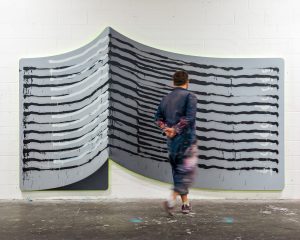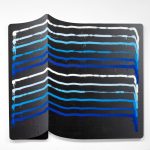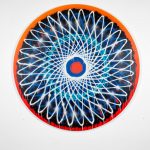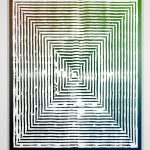Jason Williams, AKA REVOK, has been circulating recently for his generous contributions to Detroit arts organizations such as MOCAD and Living Arts Detroit. Curious for an LA-based artist. Not so curious when you realize he once lived here—and that this place means a lot to him.
He was a working artist before he first came to Detroit, but this is where his studio practice was born.
After establishing a name for himself internationally as a graffiti writer, he moved to Detroit to focus on his art. That was a handful of years ago when you could still find cheap lofts in Eastern Market. The lower cost of living allowed the LA transplant to pay his bills with freelance graphic design jobs, leaving him the bulk of his time to explore the city and his studio.
The result was a series of collages. Constructed from architectural mementos and other bits scavenged on his city adventures, they’re something of a love letter to the city. This first round of adventures in Detroit culminated with a solo show at Library Street Collective, Ordinary Things. REVOK was one of the first artists to work with the young gallery—and the first to break in their downtown space.
These early works mark a break from painting. It’s something REVOK saw as necessary to creating a studio practice distinct from his graffiti style. They also mark the beginning of a serious relationship with Detroit. After returning to the west coast, he continued collaborations with LSC, including his 2015 Los Angeles solo show, REVOK.
And, now, REVOK has returned to live and work in Detroit—and has kicked off the move with yet another solo show, depersonalization-derealization.
We caught up with REVOK to talk origins, graffiti, and Instagram.
CV Henriette: What’s the evolution of your work? When you started, did you imagine your work in a gallery?
Jason Revok: That was the farthest thing from my agenda. I grew up a kid in Southern California, obsessed with graffiti like everybody else.
I was exposed to graffiti ‘cause it was everywhere around me, and then when I started becoming interested in it—this was the late 80’s, early 90’s, pre-Internet—information was precious and you really had to work to seek it out and get access to it. I quickly identified with a number of guys, who, in a lot of ways, I emulated. For me graffiti was a very particular thing. My motivation for doing it was doing graffiti for the sake of graffiti. That’s all I cared about.
No one in my family had high education. Art wasn’t something that was revered—or even respected. Art, in my world growing up, was album covers and skateboard graphics. That’s what I was into.
I’ve painted graffiti for 30 years now. The thing about graffiti I appreciate the most, looking back now, is that it really is this cross-cultural kind of thing that brings kids—and eventually grown adults—together. People who probably would never know one another or be open to getting to know one another.
Growing up in Southern California—it doesn’t really have the reputation, but there are very hard lines that divide people. Economically, culturally, racially. There are big boundaries. The gang culture element being the most severe of all those things. Kids tend to stick with kids like them from their neighborhood, but graffiti acts as a gateway to meet other people from different walks of like and get to know them.
Graffiti is about how much heart you have and how willing you are to work.
Through that, all those other boundaries dissolve, and you get to know people for who they really are. That experience introduced me to a lot of people who opened my eyes to a totally different world. It changed my way of thinking.
I started traveling all over the country and, eventually, all over the world for graffiti and meeting a lot of people. That exposure opened my eyes to art—and to a reexamination of myself and what I was doing. Suddenly I was like “I guess I am making art. I have an art practice.”
Still, that was never my motivation. I never wanted to be a studio artist. I just wanted to do graffiti.
When I started to have ideas that didn’t fit into the context of traditional graffiti practice, and I wanted to explore those ideas and not spend all my time painting in the street, I wasn’t interested in doing “arted up” or studio version of graffiti.

REVOK. Work courtesy of Library Street Collective
CVh: Your connection to Detroit?
JR: I moved to Detroit to commit myself to that new practice.
Coming here was liberating in the sense that I could get a twenty-five hundred square foot loft in Eastern Market for like a thousand dollars a month. I could work a few days a month, doing graphic design work for clients back home [in LA], and then I owned my time. I had the rest of the month.
Every day I woke up I had complete freedom to indulge in these new ideas. Which turned into assemblages. I was going out and exploring the city, sampling little bits and pieces of the city—businesses, churches, homes, schools, whatever—all these embedded elements. Ghosts. They had layers and layers and layers. People’s lives embedded in them.
I would take them back to my studio, cut them up and reshape them. Reimagine, recontextualize and make them into something new. That work was just as much about me as it was the city.
Part of my intention was to remove my hand from the work. All the years that I’d been painting graffiti, I’d become so comfortable with a certain gestural way of painting. I’d developed my own style and language, but I didn’t want that to be present in my studio work. I didn’t want it to be about graffiti.
I did that for five or six years. Then my daughter was born, and we left Detroit.
The moment I left the city, that was the end of a chapter. I made this body of work while I was here. When I went back to LA, I quit making that work altogether.
CVh: And back in LA?
JR: I continued to use a lot of the same tools and process for a while in LA, but I knew that, at some point, I wanted to get back to painting. My intention at the beginning was to remove my hand because I didn’t want to make work that looked like my graffiti. After doing that for so long—this constricted, disciplined practice—I felt I had spent enough time and distance between me and that to where I could start exploring painting again without it looking like my wild style graffiti.
So that’s what these paintings are. I started using spray paint again in my work. I remember being a kid, stealing a can of spray paint and making a mark on a wall—how exciting that was, the chaotic nature of spray paint. A surface is a certain thing, and whoever has ownership over that surface, wants it a certain way—and when you make this aggressive mark on the surface, it’s a charged visual that has a lot of energy in it. I wanted to explore that feeling again without all the language and style and aesthetics of a particular thing.
It’s action painting, where I’m striping it down to its most raw essence.
I built this instrument—It’s a long machine that holds twelve cans of spray paint together, so I’m able to hold this instrument, and when I pull the trigger it sprays all the cans together, in one simultaneous stroke. It’s the same action, multiplied over twelve times with one basic movement.
CVh: There are a number of graffiti writers who don’t consider themselves artists. Has the development of your career come with an identity shift?
JR: Within graffiti, like anything else, you have sub-genres. My friends and I come from a shared ideology that we take what we do very, very seriously. We put a big effort into the craft.
I have a crew of guys—most of us are from LA, but some from other places. The identity that we try to carve out for ourselves is of guys who paint better than everyone else. We’ll do graffiti in a place where most people would do a throw-up, a quick two-color thing. We’ll stay there and paint something for hours, with lots of colors. It’s a lot more complex and intricate than what others are willing to do.
My crew is MSK and AWR. Our identity has always been the guys who paint better than everyone else, more than everyone else, in places other people aren’t willing to do things like that. We were graffiti writers who very much considered ourselves graffiti artists.
We’ve always painted graffiti with a certain seriousness, where we really consider what we’re doing, and we’re highly competitive. Really not much with the outside world as much as with each other. We’re always trying to outdo one another—in what we paint and by taking seriously what it is that we’re painting. That attitude probably carries itself over a bit into a studio practice.
Graffiti was always about maximalism. It was always about more, more, more. Making it more complex and trying to pack in as much as possible. A studio practice has been liberating. I’m making a conscious effort to do the exact opposite, to unpack it all and strip it down to its rawest essence. In the simplest language that I can come up with.
CVh: When you first started painting graffiti do you think it lent a means of exploration and self-expression that is now found on the Internet. How do you imagine your trajectory would have been if you came of age with Instagram?
JR: I come from this generation that exists on that crux.
I started off in the old arena. Guys like me used to meet guys across the country, and we all took photos in 35mm and would pen pal each other and see things in other places that way.
The magazine medium was also a big thing. Starting in the early ‘90s, there were a couple of guys independently publishing magazines. They were acquiring their photos the same way—meeting other guys and pen-paling.
Graffiti magazines had a huge impact on me. I grew up in the suburbs of Los Angeles, Riverside, which was outside the epicenter where graffiti was happening–LA and San Diego. There were graffiti writers everywhere. Thousands of kids were doing graffiti in my city, but it was low quality. There weren’t guys painting nice pieces.
That was happening in the big cities, New York and LA, San Francisco. We started learning what was happening in Germany, France—even Japan. My exposure to all that was through magazines.
They were published in small quantities and hard to get. The distribution was almost non-existent. You had to have access to a big city with a graffiti shop.
Growing up, outside of LA, there was this iconic graffiti guy named HEX. He had a store on Melrose, called The Hip Hop Show. All writers from everywhere went there, so that’s how you met other writers too—which usually meant everyone fighting one another.
Later on, Tower Books had a huge independent magazine and zine selection. They started buying graffiti magazines. And that inspired all these kids, from all over the world, to start independently publishing their own magazines because now they could actually get a retailer to carry their shit.
I think it was the 25th of every month when they would restock it. All the writers would rush to Tower to steal the new graffiti magazines before everyone else got them.
That was the internet then.
I’m lucky to be part of this generation where I learned that way, but have benefitted from the new technology. Really quickly, in the early 2000s, my reputation became widespread because I was lucky enough to be at that moment when all these independent websites started popping up.
That’s how I got here today. I wouldn’t be able to be doing this without the medium of the Internet.
CVh: Who are some of your influences?
JR: I like the 1950s, 1960s, big American abstract painters: Frank Stella, Rauschenberg, Ellsworth Kelly. Newer guys I find inspiring are Mark Bradford, Sterling Ruby—Tauba Auerbach is undeniably one of the most exciting artists. She’s definitely been an influence on me and how I approach my own work. There’s so many! Because of the overstimulation of the Internet, it’s hard to remember everybody.
CVh: Why Detroit?
JR: The people. Anyone who has made a conscious decision to be here is usually a pretty interesting person.
What I appreciate most about this place is the sincerity of everything. There’s not a lot of room to be pretentious or superficial here. When you meet someone, more often than not, what it is you’re talking about is actually what you’re talking about.
CVh: Advice to young artists?
JR: Don’t do graffiti.


























